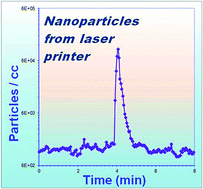Spatial and temporal variability of incidental nanoparticles in indoor workplaces: impact on the characterization of point source exposures
Abstract
This study deployed a suite of direct-reading instruments in six locations inside one building to characterize variability of the background aerosol, including incidental nanoparticles (NP), over a six month period. The instrument suite consisted of a portable Condensation Particle Counter (CPC) and a Scanning Mobility Particle Sizer (SMPS) for assessing particle number concentrations and size distributions in the nano-scale range; an Aerodynamic Particle Sizer (APS) for assessing micron-scale particle number concentrations and size distributions; plus a desktop Aerosol Monitor (DustTrak DRX) and a Diffusion Charger (DC2000CE) for assessing total particle mass and surface area concentrations respectively. In terms of number concentration, NPs (<100 nm) were the dominant particles observed in the background aerosol, contributing up to 53–93% of the total particle number concentrations. The particle size distributions were bimodal with maxima around 19–79 nm and 50–136 nm, respectively, depending on workplace locations. The average detected background particle number, surface area and total mass concentrations were below 7.1 × 103 # cm−3, 22.9 μm2 cm−3 and 33.5 μg m−3, respectively in spring samples and below 1.8 × 103 # cm−3, 10.1 μm2 cm−3 and 12.0 μg m−3, respectively in winter samples. A point source study using an older model laser printer as the emission source indicated that NPs emitted from the investigated printer were distinguishable from background. However, more recent low emitting printers are likely to be indistinguishable from background, and chemical characterization (e.g. VOCs, metals) would be required to help identify emission sources.


 Please wait while we load your content...
Please wait while we load your content...